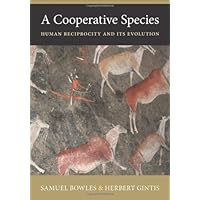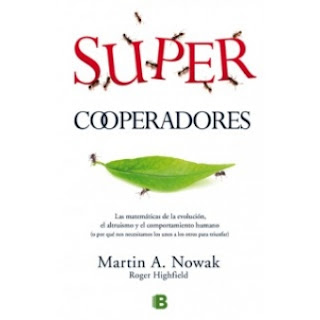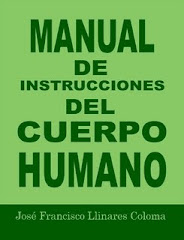Esta capacidad de ayuda mutua, que estaría integrada en nuestro ADN, explicaría diversos procesos al interior del cuerpo así como los avances médicos y la capacidad de organización de las personas para vivir en pueblos y ciudades desde hace miles de años
Viernes, 17 Julio 2015 15:52
Nuevas teorías refutan la índole instintiva de la belicosidad. El hombre no siempre hizo la guerra
Escrito por
Marylène Patou-Mathis
¿La violencia en los humanos es innata o inducida por el
contexto? Actualmente, las investigaciones antropológicas y
arqueológicas permiten responder un poco mejor esta pregunta, que
dividió a los más grandes filósofos. Al parecer, la guerra aparece sólo
con el nacimiento de la economía de producción.
---------------------------------------------------------------------------
-----------------------------------------------------------------
SuperCooperators - Altruism, Evolution, and Why We Need Each Other to Succeed by Martin Nowak and Roger Highfield.
Martin Nowak is a Harvard biologist. His book is about why humans cooperate as much as they do - which has been a classic puzzle to evolutionary biologists for decades.
Nowak's number one answer seems to be "game theory". Nowak has worked on this topic with others in the field - including William Hamilton and Ed Wilson. In combination with Karl Sigmund, he came up with some of the ideas behind what he calls "indirect reciprocity".
The book has a chatty style that tries to weave the stories of those involved into the science.
That might make the book easier to read for some, but it also makes getting at the scientific content harder. I found this aspect of the book pretty irritating. The author also focusses a lot on their own work and does not pay sufficient heed to the work of others.
Despite the author's reported enthusiasm for mathematical models, the book is almost entirely devoid of mathematics. I don't think I found a single equation - though there were some "sigmas" lying around.
Now on to some of my more serious technical issues:
The book starts out with chapters covering the basic mechanisms that the author claims produce cooperation. These are: direct reciprocity, indirect reciprocity, spatialisation, group selection and kin selection.
Spatialisation relies on reciprocity and kin selection to operate - and so barely deserves its own category, in my opinion.
Indirect reciprocity is a bit of a dustbin category - that mixes together some very different kinds of effects. I think it is better to separate these out - into
virtue signalling - which is responsible for reputations and other ways of signalling niceness and
overgeneralisation.
The list fails to mention the possibility that cooperative behaviour may have been adaptive in the past - when humans lived in close-knit tribes where kin selection and reciprocity may have played a bigger role. That's a pretty important scenario, in my opinion.
The list also fails to mention
manipulation. Manipulation is a key mechanism promoting cooperation. If an agent takes a hit to help another agent, they may simply be being manipulated. They could be being manipulated by the other party, one of the other party's friends or relatives, or by one of their own enemies.
The list also fails to mention the symbiosis theory of cooperation. Parasites and symbiotes may manipulate their hosts into friendly interactions - since they depend on interactions between their hosts to spread.
Lastly, the list also fails to make any mention of the role of culture in forging human cooperation. The author has
some awareness of this issue - since he has a chapter on the importance of language. Also he writes:
I do not restrict the use of the term “natural selection” to genes alone. Depending on whether we talk about cells, animals, or people, reproduction can be genetic or cultural. In the former case, successful individuals leave more offspring and pass more genes on to future generations. In the latter, successful ideas, fashions, and strategies spread by imitation and learning: a fad is born.
However, the treatment of culture in the book is cursory. Nowak views culture as facilitating reciprocal relationships via gossip and helping to distribute reputations.
This limited perspective is unfortunate - since cultural transmission explains why modern humans are more cooperative than beasts - and the effects of culture aren't
just down to reciprocity. In fact, cultural transmission is really what brings the symbiosis theory of cooperation to life. Memes manipulate their hosts into coming into close contact with each other - in order to facilitate their own reproduction.
There are also cultural versions of kin selection and group selection to consider - in which these phenomena act on related memes and groups of memes respectively.
So, Nowak's list of mechanisms of cooperation misses out a lot that is significant. This book needs complete rewrite to account for the forces that
actually result in human cooperation.
Nowak became infamous recently - in a bust up over kin selection. He wrote an article with E. O. Wilson about kin selection and group selection, in which kin selection got bashed. The article was called "The evolution of eusociality" and it was published in Nature. It was poorly written and was widely ridiculed. However, the group selection controvery and the role of E. O. Wilson in it is turning out to be an interesting chapter in the history of biology - and Wilson is publishing his own book on the topic later this year. One of the reasons I decided to read
SuperCooperators is to see what Nowak had to say for himself on the topic in his book.
My council for any others thinking of doing the same is: don't bother. The section in the book bashing kin selection is pretty dreadful. Nowak doesn't say anything particularly interesting or insightful in the chapter that isn't in the "eusociality" paper. Rather he reinforces the impression that he doesn't know what he is talking about. He belittles Price's equation as being "tautological" - which seems to be a
particularly stupid criticism to me. The chapter on group selection isn't much better. Group selection
is an interesting topic - but I don't recommend learning about it from Nowak. He mostly just talks about the group selection models he personally built - without giving enough information for anyone to actually reproduce them. That is not worth very much, in my opinion.
In the final chapter, Nowak proposes that "natural cooperation" be added to Darwin's "mutation" and "natural selection" principles. I think that this suggestion doesn't make sense. Instead:
production, elimination, mutation, symbiosis, synergy, self-organisation, learning and
engineering are a
much better list of fundamental evolutionary principles.
In the final chapter, Nowak explains why a scientific understanding cooperation is important for building cooperative enterprises - and that mastering cooperation is an important key for humanity when facing challenges in the modern world.
That all seems to be correct - but we need
much better science that what Nowak has to offer in order to
properly understand why humans cooperate.
There
are a few interesting bits in this book, but probably its most salient feature is the way that it misses out so much that is of vital importance to the subject it is discussing.
|
|---|
 |
A Cooperative Species: Human Reciprocity and Its Evolution by Samuel Bowles and Herbert Gintis (2011)
Why do humans, uniquely among animals, cooperate in large numbers to advance projects for the common good? Contrary to the conventional wisdom in biology and economics, this generous and civic-minded behavior is widespread and cannot be explained simply by far-sighted self-interest or a desire to help close genealogical kin. In A Cooperative Species, Samuel Bowles and Herbert Gintis--pioneers in the new experimental and evolutionary science of human behavior--show that the central issue is not why selfish people act generously, but instead how genetic and cultural evolution has produced a species in which substantial numbers make sacrifices to uphold ethical norms and to help even total strangers. View on Google Books the book page, the author page, or the book contents. |
|
 |
Why Humans Cooperate: A Cultural and Evolutionary Explanation by Joseph Henrich and Natalie Henrich (2007)
Cooperation among humans is one of the keys to our great evolutionary success. Natalie and Joseph Henrich examine this phenomena with a unique fusion of theoretical work on the evolution of cooperation, ethnographic descriptions of social behavior, and a range of other experimental results. Their experimental and ethnographic data come from a small, insular group of middle-class Iraqi Christians called Chaldeans, living in metro Detroit, whom the Henrichs use as an example to show how kinship relations, ethnicity, and culturally transmitted traditions provide the key to explaining the evolution of cooperation over multiple generations. View on Google Books the book page, the author page, or the book contents. |
|
 |
Moral Sentiments and Material Interests: The Foundations of Cooperation in Economic Life by Herbert Gintis, Samuel Bowles, Robert Boyd and Ernst Fehr (2006)
Moral Sentiments and Material Interests presents an innovative synthesis of research in different disciplines to argue that cooperation stems not from the stereotypical selfish agent acting out of disguised self-interest but from the presence of 'strong reciprocators' in a social group.Presenting an overview of research in economics, anthropology, evolutionary and human biology, social psychology, and sociology, the book deals with both the theoretical foundations and the policy implications of this explanation for cooperation. Chapter authors in the remaining parts of the book discuss the behavioral ecology of cooperation in humans and nonhuman primates, modeling and testing strong reciprocity in economic scenarios, and reciprocity and social policy. The evidence for strong reciprocity in the book includes experiments using the famous Ultimatum Game (in which two players must agree on how to split a certain amount of money or they both get nothing.) View on Google Books the book page, the author page, or the book contents. |
|
 |
Genetic and Cultural Evolution of Cooperation (Dahlem Workshop Reports) by Peter Hammerstein (2003)
Current thinking in evolutionary biology holds that competition among individuals is the key to understanding natural selection. When competition exists, it is obvious that conflict arises; the emergence of cooperation, however, is less straightforward and calls for in-depth analysis. Much research is now focused on defining and expanding the evolutionary models of cooperation. Understanding the mechanisms of cooperation has relevance for fields other than biology. Anthropology, economics, mathematics, political science, primatology, and psychology are adopting the evolutionary approach and developing analogies based on it. Similarly, biologists use elements of economic game theory and analyze cooperation in 'evolutionary games.' Despite this, exchanges between researchers in these different disciplines have been limited. Seeking to fill this gap, the 90th Dahlem Workshop was convened. This book, which grew out of that meeting, addresses such topics as emotions in human cooperation, reciprocity, biological markets, cooperation and conflict in multicellularity, genomic and intercellular cooperation, the origins of human cooperation, and the cultural evolution of cooperation; the emphasis is on open questions and future research areas. The book makes a significant contribution to a growing process of interdisciplinary cross-fertilization on this issue. View on Google Books the book page, the author page, or the book contents. |
|
 |
Foundations of Human Sociality: Economic Experiments and Ethnographic Evidence from Fifteen Small-Scale Societies by Joseph Henrich, Robert Boyd, Samuel Bowles, Colin Camerer, Ernst Fehr, Herbert Gintis (2000)
This path-breaking book addresses the nature of human sociality. By bringing together experimental and ethnographic data from fifteen different tribal societies, the contributors are able to explore the universality of human motives in economic decision-making, and the importance of social, institutional and cultural factors, in a manner that has been extremely rare in the social sciences. Its findings have far-reaching implications across the social sciences. View on Google Books the book page, the author page, or the book contents. |
|
| Kin selection |
|---|
 |
The Price of Altruism: George Price and the Search for the Origins of Kindness by Oren Harman (2011)
Survival of the fittest or survival of the nicest? Since the dawn of time man has contemplated the mystery of altruism, but it was Darwin who posed the question most starkly. From the selfless ant to the stinging bee to the man laying down his life for a stranger, evolution has yielded a goodness that in theory should never be. Set against the sweeping tale of 150 years of scientific attempts to explain kindness, The Price of Altruism tells for the first time the moving story of the eccentric American genius George Price (1922–1975), as he strives to answer evolution's greatest riddle. An original and penetrating picture of twentieth century thought, it is also a deeply personal journey. From the heights of the Manhattan Project to the inspired equation that explains altruism to the depths of homelessness and despair, Price's life embodies the paradoxes of Darwin’s enigma. His tragic suicide in a squatter’s flat, among the vagabonds to whom he gave all his possessions, provides the ultimate contemplation on the possibility of genuine benevolence. 24 black-and-white illustrations |
|
 |
Narrow Roads of Gene Land: The Collected Papers of W. D. Hamilton Volume 1: Evolution of Social Behaviour by W. D. Hamilton (2011)
Why is `blood thicker than water'? Are we innately violent or pacific? Why are plants and animals sexual? Why do we grow old and die? Such questions have motivated the life-work of W.D. Hamilton, widely acknowledged as the most important theoretical biologist of the 20th century. His papers continue to exert an enormous influence and they are now being republished for the first time. This first volume contains all of Hamilton's publications prior to 1981, a set especially relevant to social behavior, kinship theory, sociobiology, and the notion of `selfish genes'. Each paper is introduced by an autobiographical essay written especially for this collection. Accessible to non-specialists, this fascinating volume features several of the most read and famous papers of modern biology. |
|
 |
Social Evolution by Robert Trivers (1985)
This textbook provides a good overview of social evolution. It is written in simple, easy-to-understand language and is accessable to most readers. |
|
| Reciprocal altruism |
|---|
 |
The Evolution of Cooperation: Revised Edition by Robert Axelrod (2006)
The Evolution of Cooperation provides valuable insights into the age-old question of whether unforced cooperation is ever possible. Widely praised and much-discussed, this classic book explores how cooperation can emerge in a world of self-seeking egoists-whether superpowers, businesses, or individuals-when there is no central authority to police their actions. The problem of cooperation is central to many different fields. Robert Axelrod recounts the famous computer tournaments in which the “cooperative” program Tit for Tat recorded its stunning victories, explains its application to a broad spectrum of subjects, and suggests how readers can both apply cooperative principles to their own lives and teach cooperative principles to others. |
|
 |
The Complexity of Cooperation: Agent-Based Models of Competition and Collaboration by Robert Axelrod (1997)
Robert Axelrod is widely known for his groundbreaking work in game theory and complexity theory. He is a leader in applying computer modeling to social science problems. His book The Evolution of Cooperation has been hailed as a seminal contribution and has been translated into eight languages since its initial publication. The Complexity of Cooperation is a sequel to that landmark book. It collects seven essays, originally published in a broad range of journals, and adds an extensive new introduction to the collection, along with new prefaces to each essay and a useful new appendix of additional resources. Written in Axelrod's acclaimed, accessible style, this collection serves as an introductory text on complexity theory and computer modeling in the social sciences and as an overview of the current state of the art in the field. The articles move beyond the basic paradigm of the Prisoner's Dilemma to study a rich set of issues, including how to cope with errors in perception or implementation, how norms emerge, and how new political actors and regions of shared culture can develop. They use the shared methodology of agent-based modeling, a powerful technique that specifies the rules of interaction between individuals and uses computer simulation to discover emergent properties of the social system. The Complexity of Cooperation is essential reading for all social scientists who are interested in issues of cooperation and complexity. |
|
| Superorganisms |
|---|
 |
The Extended Organism: The Physiology of Animal-Built Structures by J. Scott Turner (2002)
Can the structures that animals build - from the humble burrows of earthworms to towering termite mounds to the Great Barrier Reef--be said to live? However counterintuitive the idea might first seem, physiological ecologist Scott Turner demonstrates in this book that many animals construct and use structures to harness and control the flow of energy from their environment to their own advantage. Building on Richard Dawkins's classic, The Extended Phenotype, Turner shows why drawing the boundary of an organism's physiology at the skin of the animal is arbitrary. Since the structures animals build undoubtedly do physiological work, capturing and channeling chemical and physical energy, Turner argues that such structures are more properly regarded not as frozen behaviors but as external organs of physiology and even extensions of the animal's phenotype. By challenging dearly held assumptions, a fascinating new view of the living world is opened to us, with implications for our understanding of physiology, the environment, and the remarkable structures animals build. |
|
 |
The Superorganism: The Beauty, Elegance, and Strangeness of Insect Societies by Bert Hölldobler and Edward O. Wilson (2008)
The Superorganism promises to be one of the most important scientific works published in this decade. Coming eighteen years after the publication of The Ants, this new volume expands our knowledge of the social insects (among them, ants, bees, wasps, and termites) and is based on remarkable research conducted mostly within the last two decades. These superorganisms—a tightly knit colony of individuals, formed by altruistic cooperation, complex communication, and division of labor—represent one of the basic stages of biological organization, midway between the organism and the entire species. The study of the superorganism, as the authors demonstrate, has led to important advances in our understanding of how the transitions between such levels have occurred in evolution and how life as a whole has progressed from simple to complex forms. Ultimately, this book provides a deep look into a part of the living world hitherto glimpsed by only a very few. |
|
| Group selection |
|---|
 |
Unto Others: The Evolution and Psychology of Unselfish Behavior by Elliott Sober and David Sloan Wilson (2000)
In Unto Others, philosopher Elliott Sober and biologist David Sloan Wilson bravely attempt to reconcile altruism, both evolutionary and psychological, with the scientific discoveries that seem to portray nature as red in tooth and claw. The first half of the book deals with the evolutionary objection to altruism. For altruistic behavior to be produced by natural selection, it must be possible for natural selection to act on groups - but conventional wisdom holds that group selection was conclusively debunked by George Williams in Adaptation and Natural Selection. Sober and Wilson nevertheless defend group selection, instructively reviewing the arguments against it and citing important work that relies on it. They then discuss group selection in human evolution, testing their conclusions against the anthropological literature. View on Google Books the book page, the author page, or the book contents. |
|
| Misc |
|---|
 |
SuperCooperators: Altruism, Evolution, and Why We Need Each Other to Succeed by Martin Nowak and Roger Highfield (2011)
EVOLUTION IS OFTEN PRESENTED AS A STRICTLY COMPETITIVE ENDEAVOR. This point of view has had serious implications for the way we see the mechanics of both science and culture. But scientists have long wondered how societies could have evolved without some measure of cooperation. And if there was cooperation involved, how could it have arisen from nature “red in tooth and claw”? Martin Nowak, one of the world’s experts on evolution and game theory, working here with bestselling science writer Roger Highfield, turns an important aspect of evolutionary theory on its head to explain why cooperation, not competition, has always been the key to the evolution of complexity. He offers a new explanation for the origin of life and a new theory for the origins of language, biology’s second greatest information revolution after the emergence of genes. SuperCooperators also brings to light his game-changing work on disease. Cancer is fundamentally a failure of the body’s cells to cooperate, Nowak has discovered, but organs are cleverly designed to foster cooperation, and he explains how this new understanding can be used in novel cancer treatments. Nowak and Highfield examine the phenomena of reciprocity, reputation, and reward, explaining how selfless behavior arises naturally from competition; how forgiveness, generosity, and kindness have a mathematical rationale; how companies can be better designed to promote cooperation; and how there is remarkable overlap between the recipe for cooperation that arises from quantitative analysis and the codes of conduct seen in major religions, such as the Golden Rule. View on Google Books the book page, the author page, or the book contents. |
|
 |
The Altruism Equation: Seven Scientists Search for the Origins of Goodness by Lee Alan Dugatkin (2006)
In a world supposedly governed by ruthless survival of the fittest, why do we see acts of goodness in both animals and humans? This problem plagued Charles Darwin in the 1850s as he developed his theory of evolution through natural selection. Indeed, Darwin worried that the goodness he observed in nature could be the Achilles heel of his theory. Ever since then, scientists and other thinkers have engaged in a fierce debate about the origins of goodness that has dragged politics, philosophy, and religion into what remains a major question for evolutionary biology. The Altruism Equation traces the history of this debate from Darwin to the present through an extraordinary cast of characters-from the Russian prince Petr Kropotkin, who wanted to base society on altruism, to the brilliant biologist George Price, who fell into poverty and succumbed to suicide as he obsessed over the problem. In a final surprising turn, William Hamilton, the scientist who came up with the equation that reduced altruism to the cold language of natural selection, desperately hoped that his theory did not apply to humans. Hamilton's Rule, which states that relatives are worth helping in direct proportion to their blood relatedness, is as fundamental to evolutionary biology as Newton's laws of motion are to physics. But even today, decades after its formulation, Hamilton's Rule is still hotly debated among those who cannot accept that goodness can be explained by a simple mathematical formula. For the first time, Lee Alan Dugatkin brings to life the people, the issues, and the passions that have surrounded the altruism debate. Readers will be swept along by this fast-paced tale of history, biography, and scientific discovery. |
|
 |
The Calculus of Selfishness by Karl Sigmund (2011)
How does cooperation emerge among selfish individuals? When do people share resources, punish those they consider unfair, and engage in joint enterprises? These questions fascinate philosophers, biologists, and economists alike, for the "invisible hand" that should turn selfish efforts into public benefit is not always at work. The Calculus of Selfishness looks at social dilemmas where cooperative motivations are subverted and self-interest becomes self-defeating. Karl Sigmund, a pioneer in evolutionary game theory, uses simple and well-known game theory models to examine the foundations of collective action and the effects of reciprocity and reputation. Focusing on some of the best-known social and economic experiments, including games such as the Prisoner's Dilemma, Trust, Ultimatum, Snowdrift, and Public Good, Sigmund explores the conditions leading to cooperative strategies. His approach is based on evolutionary game dynamics, applied to deterministic and probabilistic models of economic interactions. Exploring basic strategic interactions among individuals guided by self-interest and caught in social traps, The Calculus of Selfishness analyzes to what extent one key facet of human nature - selfishness - can lead to cooperation. |
|
 |
The Origins of Virtue: Human Instincts and the Evolution of Cooperation by Matt Ridley (2006)
If, as Darwin suggests, evolution relentlessly encourages the survival of the fittest, why are humans compelled to live in cooperative, complex societies? In this fascinating examination of the roots of human trust and virtue, a zoologist and former American editor of the Economist reveals the results of recent studies that suggest that self-interest and mutual aid are not at all incompatible. In fact, he points out, our cooperative instincts may have evolved as part of mankind's natural selfish behavior - by exchanging favors we can benefit ourselves as well as others. Brilliantly orchestrating the newest findings of geneticists, psychologists, and anthropologists, The Origins of Virtue re-examines the everyday assumptions upon which we base our actions towards others, whether in our roles as parents, siblings, or trade partners. With the wit and brilliance of The Red Queen, his acclaimed study of human and animal sexuality, Matt Ridley shows us how breakthroughs in computer programming, microbiology, and economics have given us a new perspective on how and why we relate to each other. |
|







































No hay comentarios:
Publicar un comentario